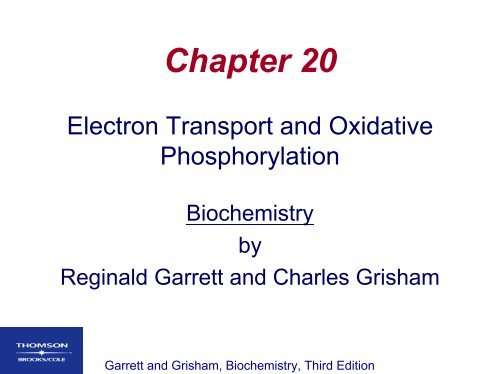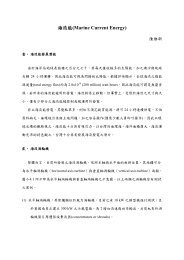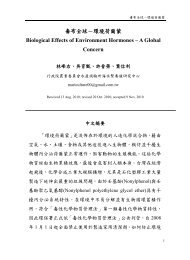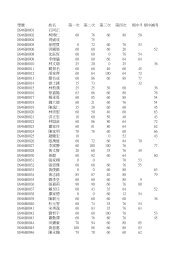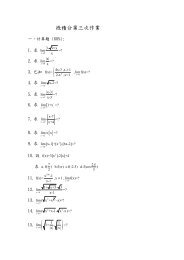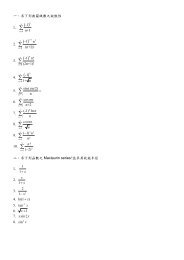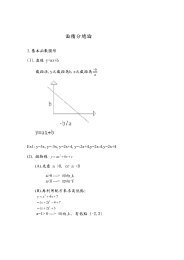Electron Transport and Oxidative Phosphorylation
Electron Transport and Oxidative Phosphorylation
Electron Transport and Oxidative Phosphorylation
Create successful ePaper yourself
Turn your PDF publications into a flip-book with our unique Google optimized e-Paper software.
Chapter 20<br />
<strong>Electron</strong> <strong>Transport</strong> <strong>and</strong> <strong>Oxidative</strong><br />
<strong>Phosphorylation</strong><br />
Biochemistry<br />
by<br />
Reginald Garrett <strong>and</strong> Charles Grisham<br />
Garrett <strong>and</strong> Grisham, Biochemistry, Third Edition
Garrett <strong>and</strong> Grisham, Biochemistry, Third Edition<br />
Essential Question<br />
• How do cells oxidize NADH <strong>and</strong> [FADH 2 ] <strong>and</strong><br />
convert their reducing potential into the<br />
chemical energy of ATP?
Garrett <strong>and</strong> Grisham, Biochemistry, Third Edition<br />
Outline<br />
• Where in the Cell Are <strong>Electron</strong> <strong>Transport</strong> <strong>and</strong> <strong>Oxidative</strong><br />
<strong>Phosphorylation</strong> Carried Out?<br />
• What Are Reduction Potentials, <strong>and</strong> How Are They<br />
Used to Account for Free Energy Changes in Redox<br />
Reactions?<br />
• How Is the <strong>Electron</strong>-<strong>Transport</strong> Chain Organized?<br />
• What Are the Thermodynamic Implications of<br />
Chemiosmotic Coupling?<br />
• How Does a Proton Gradient Drive the Synthesis of<br />
ATP?<br />
• What Is the P/O Ratio for Mitochondrial <strong>Electron</strong><br />
<strong>Transport</strong> <strong>and</strong> <strong>Oxidative</strong> <strong>Phosphorylation</strong>?<br />
• How Are the <strong>Electron</strong>s of Cytosolic NADH Fed into<br />
<strong>Electron</strong> <strong>Transport</strong>?
Garrett <strong>and</strong> Grisham, Biochemistry, Third Edition<br />
20.1 - Where in the Cell Are<br />
<strong>Electron</strong> <strong>Transport</strong> <strong>and</strong> <strong>Oxidative</strong><br />
<strong>Phosphorylation</strong> Carried Out?<br />
• <strong>Electron</strong> <strong>Transport</strong>: <strong>Electron</strong>s carried by<br />
reduced coenzymes are passed through a chain<br />
of proteins <strong>and</strong> coenzymes to drive the<br />
generation of a proton gradient across the inner<br />
mitochondrial membrane<br />
• <strong>Oxidative</strong> <strong>Phosphorylation</strong>: The proton gradient<br />
runs downhill to drive the synthesis of ATP<br />
• It all happens in or at the inner mitochondrial<br />
membrane
Figure 20.1<br />
(a) A drawing of a mitochondrion with components labeled. (b) Tomography of a rat liver<br />
mitochondrion. The tubular structures in red, yellow, green, purple, <strong>and</strong> aqua represent<br />
individual cristae formed from the inner mitochondrial membrane. (b,Frey, T.G., <strong>and</strong><br />
Mannella, C.A.,2000. The internal structure of mitochondria. Trends in Biochemical Sciences<br />
25:319-324.)<br />
Garrett <strong>and</strong> Grisham, Biochemistry, Third Edition
Garrett <strong>and</strong> Grisham, Biochemistry, Third Edition<br />
20.2 – What Are Reduction Potentials, <strong>and</strong><br />
How Are They Used to Account for Free<br />
Energy Changes in Redox Reactions?<br />
High E o ' indicates a strong tendency to be reduced<br />
• Crucial equation: ∆G o ' = -nF∆E o '<br />
∆E o ' = E o '(acceptor) - E o '(donor)<br />
• <strong>Electron</strong>s are donated by the half reaction with<br />
the more negative reduction potential <strong>and</strong> are<br />
accepted by the reaction with the more positive<br />
reduction potential: ∆E o ' positive, ∆G o ' negative<br />
• If a given reaction is written so the reverse is true,<br />
then the ∆E o ' will be a negative number <strong>and</strong> ∆G o '<br />
will be positive
Figure 20.2<br />
Experimental apparatus<br />
used to measure the<br />
st<strong>and</strong>ard reduction potential<br />
of the indicated redox<br />
couples: (a) the<br />
acetaldehyde/ethanol<br />
couple, (b) the<br />
fumarate/succinate couple,<br />
(c) the Fe 3+ /Fe 2+ couple.<br />
Garrett <strong>and</strong> Grisham, Biochemistry, Third Edition
20.3 – How Is the <strong>Electron</strong> <strong>Transport</strong><br />
Chain Organized?<br />
Figures 20.3 <strong>and</strong> 20.4 hold the secrets<br />
• Four protein complexes in the inner<br />
mitochondrial membrane<br />
• A lipid soluble coenzyme (UQ, CoQ) <strong>and</strong> a<br />
water soluble protein (cyt c) shuttle between<br />
protein complexes<br />
• <strong>Electron</strong>s generally fall in energy through the<br />
chain - from complexes I <strong>and</strong> II to complex IV<br />
Garrett <strong>and</strong> Grisham, Biochemistry, Third Edition
Figure 20.3<br />
E o΄ <strong>and</strong> E values for the<br />
components of the<br />
mitochondrial electrontransport<br />
chain. Values<br />
indicated are consensus<br />
values for animal<br />
mitochondria. Black bars<br />
represent E o΄; red bars,<br />
E.<br />
Garrett <strong>and</strong> Grisham, Biochemistry, Third Edition
Figure 20.4<br />
An overview of the complexes <strong>and</strong> pathways in the mitochondrial electron-transport<br />
chain. (Adapted from Nicholls,D.G., <strong>and</strong> Ferguson,S.J., 2002. Bioenergetics 3. London:<br />
Academic Press.)<br />
Garrett <strong>and</strong> Grisham, Biochemistry, Third Edition
Figure 20.5<br />
(a) The three oxidation states of coenzyme Q. (b) A space-filling model of<br />
coenzyme Q.<br />
Garrett <strong>and</strong> Grisham, Biochemistry, Third Edition
Complex I Oxidizes NADH <strong>and</strong><br />
Reduces Coenzyme Q<br />
NADH-CoQ Reductase<br />
• <strong>Electron</strong> transfer from NADH to CoQ<br />
• More than 30 protein subunits - mass of<br />
850 kD<br />
• Path:<br />
NADH → FMN → Fe-S → UQ→ FeS → UQ<br />
• Four H + transported out per 2 e -<br />
Garrett <strong>and</strong> Grisham, Biochemistry, Third Edition
Figure 20.6<br />
Proposed structure<br />
<strong>and</strong> electron<br />
transport pathway<br />
for Complex I. Three<br />
protein complexes<br />
have been isolated,<br />
including the<br />
flavoprotein (FP),<br />
iron-sulfur protein<br />
(IP), <strong>and</strong><br />
hydrophobic<br />
protein (HP). FP<br />
contains three<br />
peptides (of mass<br />
51, 24, <strong>and</strong> 10 kD)<br />
<strong>and</strong> bound FMN <strong>and</strong><br />
has 2 Fe-S centers<br />
(a 2Fe-2S center<br />
<strong>and</strong> a 4Fe-4S<br />
center). IP contains<br />
six peptides <strong>and</strong> at<br />
least 3 Fe-S centers.<br />
HP contains at least<br />
seven peptides <strong>and</strong><br />
one Fe-S center.<br />
Garrett <strong>and</strong> Grisham, Biochemistry, Third Edition
Garrett <strong>and</strong> Grisham, Biochemistry, Third Edition<br />
Complex II Oxidizes Succinate<br />
<strong>and</strong> Reduces Coenzyme Q<br />
Succinate-CoQ Reductase<br />
• aka succinate dehydrogenase (from TCA cycle!)<br />
• aka flavoprotein 2 (FP 2 ) - FAD covalently bound<br />
• four subunits, including 2 Fe-S proteins<br />
• Three types of Fe-S cluster:<br />
4Fe-4S, 3Fe-4S, 2Fe-2S<br />
• Path: succinate → FADH 2 → 2Fe 2+ → UQH 2<br />
• Net reaction:<br />
succinate + UQ → fumarate + UQH 2
Figure 20.7<br />
The fatty acyl-CoA dehydrogenase reaction, emphasizing that the reaction<br />
involves reduction of enzyme-bound FAD (indicated by brackets).<br />
Garrett <strong>and</strong> Grisham, Biochemistry, Third Edition
Figure 20.8<br />
A probable scheme for electron flow in Complex II. Oxidation of succinate occurs with<br />
reduction of [FAD]. <strong>Electron</strong>s are then passed to Fe-S centers <strong>and</strong> then to coenzyme Q<br />
(UQ). Proton transport does not occur in this complex.<br />
Garrett <strong>and</strong> Grisham, Biochemistry, Third Edition
Garrett <strong>and</strong> Grisham, Biochemistry, Third Edition<br />
Complex III Mediates <strong>Electron</strong> <strong>Transport</strong><br />
from Coenzyme Q to Cytochrome c<br />
CoQ-Cytochrome c Reductase<br />
• CoQ passes electrons to cyt c (<strong>and</strong> pumps H + ) in a<br />
unique redox cycle known as the Q cycle<br />
• The principal transmembrane protein in complex III<br />
is the b cytochrome - with hemes b L <strong>and</strong> b H<br />
• Cytochromes, like Fe in Fe-S clusters, are oneelectron<br />
transfer agents<br />
• Study Figure 20.12 - the Q cycle<br />
• UQH 2 is a lipid-soluble electron carrier<br />
• cyt c is a water-soluble electron carrier
Figure 20.9<br />
Typical visible<br />
absorption spectra of<br />
cytochromes. (a)<br />
Cytochrome c, reduced<br />
spectrum; (b)<br />
cytochrome c, oxidized<br />
spectrum; (c) the<br />
difference spectrum: (a)<br />
minus (b); (d) beef heart<br />
mitochondrial particles:<br />
room temperature<br />
difference (reduced<br />
minus oxidized)<br />
spectrum; (e) beef heart<br />
submitochondrial<br />
particles: same as (d)<br />
but at 77 K. α- <strong>and</strong> β-<br />
b<strong>and</strong>s are labeled, <strong>and</strong><br />
in (d) <strong>and</strong> (e) the b<strong>and</strong>s<br />
for cytochromes a, b <strong>and</strong><br />
c are indicated.<br />
Garrett <strong>and</strong> Grisham, Biochemistry, Third Edition
Figure 20.10<br />
The structures of iron<br />
protoporphyrin IX, heme c,<br />
<strong>and</strong> heme a.<br />
Garrett <strong>and</strong> Grisham, Biochemistry, Third Edition
Figure 20.11<br />
The structure of UQ-cyt c<br />
reductase, also known as<br />
the cytochrome bc 1<br />
complex. The α-helices of<br />
cytochrome b (pale green)<br />
define the transmembrane<br />
domain of the protein. The<br />
bottom of the structure as<br />
shown extends<br />
approximately 75 Å into the<br />
mitochondrial matrix, <strong>and</strong><br />
the top of the structure as<br />
shown extends about 38 Å<br />
into the intermembrane<br />
space. (Photograph kindly<br />
provided by Di Xia <strong>and</strong> Johann<br />
Deisenhofer [From Xia, D.,<br />
Yu,C.-A., Kim, H., Xia, J.-Z.,<br />
Kachurin, A. M., Zhang, L., Yu,<br />
L., <strong>and</strong> Deisenhofer, J., 1997.<br />
The crystal structure of the<br />
cytochrome bc1 complex from<br />
bovine heart mitochondria.<br />
Science 277:60-66.])<br />
Garrett <strong>and</strong> Grisham, Biochemistry, Third Edition
Figure 20.12<br />
The Q cycle in<br />
mitochondria. (a) The<br />
electron transfer<br />
pathway following<br />
oxidation of the first<br />
UQH 2 at the Q p site near<br />
the cytosolic face of the<br />
membrane. (b) The<br />
pathway following<br />
oxidation of a second<br />
UQH 2 .<br />
Garrett <strong>and</strong> Grisham, Biochemistry, Third Edition
Figure 20.13<br />
The structure of<br />
mitochondrial<br />
cytochrome c. The<br />
heme is shown at<br />
the center of the<br />
structure,<br />
covalently linked to<br />
the protein via its<br />
two sulfur atoms<br />
(yellow). A third<br />
sulfur from a<br />
methionine residue<br />
coordinates the<br />
iron.<br />
Garrett <strong>and</strong> Grisham, Biochemistry, Third Edition
Garrett <strong>and</strong> Grisham, Biochemistry, Third Edition<br />
Complex IV Transfers <strong>Electron</strong>s from<br />
Cytochrome c to Reduce Oxygen on<br />
the Matrix Side<br />
Cytochrome c Oxidase<br />
• <strong>Electron</strong>s from cyt c are used in a fourelectron<br />
reduction of O 2 to produce 2H 2 O<br />
• Oxygen is thus the terminal acceptor of<br />
electrons in the electron transport pathway<br />
- the end!<br />
• Cytochrome c oxidase utilizes 2 hemes (a<br />
<strong>and</strong> a 3 ) <strong>and</strong> 2 copper sites<br />
• Structure is now known - mostly!<br />
• Complex IV also transports H +
Figure 20.15<br />
Molecular graphic image<br />
of subunits I,II, <strong>and</strong> III of<br />
cytochrome c oxidase.<br />
Garrett <strong>and</strong> Grisham, Biochemistry, Third Edition
Figure 20.16<br />
Molecular graphic image of<br />
cytochrome c oxidase. Seven of the<br />
10 nuclear DNA-derived subunits<br />
(IV, VIa, VIc, VIIa, VIIb, VIIc, <strong>and</strong><br />
VIII) possess transmembrane<br />
segments. Three (Va, Vb, <strong>and</strong> VIb)<br />
do not. Subunits IV <strong>and</strong> VIc are<br />
transmembrane <strong>and</strong> dumbbellshaped.<br />
Subunit Va is globular <strong>and</strong><br />
bound to the matrix side of the<br />
complex, whereas VIb is a globular<br />
subunit on the cytosolic side of the<br />
membrane complex. Vb is globular<br />
<strong>and</strong> matrix-side associated as well,<br />
but it has an N-terminal extended<br />
domain. VIa has a transmembrane<br />
helix <strong>and</strong> a small globular domain.<br />
Subunit VIIa consists of a tilted<br />
transmembrane helix, with another<br />
short helical segment on the matrix<br />
side of the membrane. Subunits<br />
VIIa, VIIb, <strong>and</strong> VIII consist of<br />
transmembrane segments with short<br />
extended regions outside the<br />
membrane.<br />
Garrett <strong>and</strong> Grisham, Biochemistry, Third Edition
Figure 20.17<br />
The electron transfer<br />
pathway for cytochrome<br />
oxidase. Cytochrome c<br />
binds on the cytosolic<br />
side, transferring<br />
electrons through the<br />
copper <strong>and</strong> heme<br />
centers to reduce O 2 on<br />
the matrix side of the<br />
membrane.<br />
Garrett <strong>and</strong> Grisham, Biochemistry, Third Edition
Figure 20.18<br />
(a) The Cu A site of cytochrome oxidase. Copper lig<strong>and</strong>s include two histidine<br />
imidazole groups <strong>and</strong> two cysteine side chains from the protein. (b) The<br />
coordination of histidine imidazole lig<strong>and</strong>s to the iron atom in the heme a center<br />
of cytochrome oxidase.<br />
Garrett <strong>and</strong> Grisham, Biochemistry, Third Edition
Figure 20.19<br />
The binuclear center<br />
of cytochrome<br />
oxidase. A lig<strong>and</strong>, L<br />
(probably a cysteine<br />
S), is shown bridging<br />
the Cu B <strong>and</strong> Fe of<br />
heme a 3 metal sites.<br />
Garrett <strong>and</strong> Grisham, Biochemistry, Third Edition
Figure 20.20<br />
A model for the mechanism of O 2 reduction by cytochrome oxidase.<br />
(Adapted from Nicholls, D. G., <strong>and</strong> Ferguson, S. J., 1992. Bioenergetics 2. London: Academic Press; <strong>and</strong><br />
Babcock, G. T., <strong>and</strong> Wikström, M., 1992. Nature 356:301-309.)<br />
Garrett <strong>and</strong> Grisham, Biochemistry, Third Edition
Garrett <strong>and</strong> Grisham, Biochemistry, Third Edition<br />
20.4 – What Are the Thermodynamic<br />
Implications of Chemiosmotic Coupling?<br />
This coupling was a mystery for many years<br />
• Many biochemists squ<strong>and</strong>ered careers searching<br />
for the elusive "high energy intermediate"<br />
• Peter Mitchell proposed a novel idea - a proton<br />
gradient across the inner membrane could be used<br />
to drive ATP synthesis<br />
• Mitchell was ridiculed, but the chemiosmotic<br />
hypothesis eventually won him a Nobel prize<br />
• Be able to calculate the ∆G for a proton gradient<br />
(Equation 20.24)
Figure 20.21<br />
A model for the electron transport pathway in the mitochondrial inner membrane. UQ/UQH 2<br />
<strong>and</strong> cytochrome c are mobile electron carriers <strong>and</strong> function by transferring electrons between<br />
the complexes. The proton transport driven by Complexes I, III, <strong>and</strong> IV is indicated.<br />
Garrett <strong>and</strong> Grisham, Biochemistry, Third Edition
Garrett <strong>and</strong> Grisham, Biochemistry, Third Edition<br />
20.5 – How Does a Proton Gradient<br />
Drive the Synthesis of ATP?<br />
Proton diffusion through the protein drives ATP<br />
synthesis!<br />
• Two parts: F 1 <strong>and</strong> F 0 (latter was originally<br />
"F 0 " for its inhibition by oligomycin)<br />
• See Figure 20.25 <strong>and</strong> Table 20.3 for details<br />
• Racker & Stoeckenius confirmed Mitchell’s<br />
hypothesis using vesicles containing the ATP<br />
synthase <strong>and</strong> bacteriorhodopsin<br />
• Paul Boyer’s binding change mechanism<br />
won a share of the 1997 Nobel in Chemistry
Figure 20.24<br />
Molecular graphic<br />
images (a) side view <strong>and</strong><br />
(b) top view of the F 1 -<br />
ATP synthase showing<br />
the individual component<br />
peptides. The -subunit<br />
is the pink structure<br />
visible in the center of<br />
view (b).<br />
Garrett <strong>and</strong> Grisham, Biochemistry, Third Edition
Garrett <strong>and</strong> Grisham, Biochemistry, Third Edition<br />
Figure 20.25<br />
A model of the F 1 <strong>and</strong> F 0 components of the ATP synthase, a rotating molecular motor.<br />
The <strong>and</strong> subunits constitute the stator of the motor, <strong>and</strong> the c, ,<br />
<strong>and</strong> subunits form the rotor. Flow of protons through the structure turns the rotor <strong>and</strong><br />
drives the cycle of conformational changes in <strong>and</strong> that synthesize ATP.
Figure 20.26<br />
ATP production in the presence of a proton gradient <strong>and</strong> ATP/ADP exchange in the<br />
absence of a proton gradient. Exchange leads to incorporation of 18 O in phosphate as<br />
shown.<br />
Garrett <strong>and</strong> Grisham, Biochemistry, Third Edition
Figure 20.27<br />
The binding change mechanism for<br />
ATP synthesis by ATP synthase.<br />
This model assumes that F 1 has<br />
three interacting <strong>and</strong><br />
conformationally distinct active sites.<br />
The open (O) conformation is<br />
inactive <strong>and</strong> has a low affinity for<br />
lig<strong>and</strong>s; the L conformation (with<br />
“loose” affinity for lig<strong>and</strong>s) is also<br />
inactive; the tight (T) conformation is<br />
active <strong>and</strong> has a high affinity for<br />
lig<strong>and</strong>s. Synthesis of ATP is initiated<br />
(step 1) by binding of ADP <strong>and</strong> Pi to<br />
an L site. In the second step, an<br />
energy-driven conformational<br />
change converts the L site to a T<br />
conformation <strong>and</strong> also converts T to<br />
O <strong>and</strong> O to L. In the third step, ATP<br />
is synthesized at the T site <strong>and</strong><br />
released from the O site. Two<br />
additional passes through this cycle<br />
produce two more ATPs <strong>and</strong> return<br />
the enzyme to its original state.<br />
Garrett <strong>and</strong> Grisham, Biochemistry, Third Edition
Figure 20.28<br />
The reconstituted<br />
vesicles containing ATP<br />
synthase <strong>and</strong><br />
bacteriorhodopsin used<br />
by Stoeckenius <strong>and</strong><br />
Racker to confirm the<br />
Mitchell chemiosmotic<br />
hypothesis.<br />
Garrett <strong>and</strong> Grisham, Biochemistry, Third Edition
Garrett <strong>and</strong> Grisham, Biochemistry, Third Edition<br />
Inhibitors of <strong>Oxidative</strong><br />
<strong>Phosphorylation</strong> Reveal Insights<br />
About the Mechanism<br />
• Rotenone inhibits Complex I - <strong>and</strong> helps<br />
natives of the Amazon rain forest catch<br />
fish!<br />
• Cyanide, azide <strong>and</strong> CO inhibit Complex IV,<br />
binding tightly to the ferric form (Fe 3+ ) of a 3<br />
• Oligomycin <strong>and</strong> DCCD are ATP synthase<br />
inhibitors
Figure 20.29<br />
The structures of several inhibitors of electron transport <strong>and</strong> oxidative<br />
phosphorylation.<br />
Garrett <strong>and</strong> Grisham, Biochemistry, Third Edition
Figure 20.30<br />
The sites of action of several inhibitors of electron transport <strong>and</strong>/or oxidative<br />
phosphorylation.<br />
Garrett <strong>and</strong> Grisham, Biochemistry, Third Edition
Garrett <strong>and</strong> Grisham, Biochemistry, Third Edition<br />
Uncouplers Disrupt the Coupling of<br />
<strong>Electron</strong> <strong>Transport</strong> <strong>and</strong> ATP<br />
Synthase<br />
Uncoupling e - transport <strong>and</strong> oxidative<br />
phosphorylation<br />
• Uncouplers disrupt the tight coupling between<br />
electron transport <strong>and</strong> oxidative phosphorylation<br />
by dissipating the proton gradient<br />
• Uncouplers are hydrophobic molecules with a<br />
dissociable proton<br />
• They shuttle back <strong>and</strong> forth across the<br />
membrane, carrying protons to dissipate the<br />
gradient
Figure 20.31<br />
Structures of several<br />
uncouplers, molecules<br />
that dissipate the proton<br />
gradient across the inner<br />
mitochondrial membrane<br />
<strong>and</strong> thereby destroy the<br />
tight coupling between<br />
electron transport <strong>and</strong><br />
the ATP synthase<br />
reaction.<br />
Garrett <strong>and</strong> Grisham, Biochemistry, Third Edition
Garrett <strong>and</strong> Grisham, Biochemistry, Third Edition<br />
ATP-ADP Translocase Mediates the<br />
Movement of ATP <strong>and</strong> ADP Across<br />
the Mitochondrial Membrane<br />
ATP must be transported out of the mitochondria<br />
• ATP out, ADP in - through a "translocase"<br />
• ATP movement out is favored because the<br />
cytosol is "+" relative to the "-" matrix<br />
• But ATP out <strong>and</strong> ADP in is net movement of a<br />
negative charge out - equivalent to a H + going in<br />
• So every ATP transported out costs one H +<br />
• One ATP synthesis costs about 3 H +<br />
• Thus, making <strong>and</strong> exporting 1 ATP = 4H +
Figure 20.32<br />
Outward transport of ATP (via the ATP/ADP translocase) is favored by the membrane<br />
electrochemical potential.<br />
Garrett <strong>and</strong> Grisham, Biochemistry, Third Edition
20.6 - What Is the P/O Ratio for<br />
Mitochondrial <strong>Electron</strong> <strong>Transport</strong> <strong>and</strong><br />
<strong>Oxidative</strong> <strong>Phosphorylation</strong>?<br />
i.e., How many ATP made per electron pair<br />
through the chain?<br />
• e - transport chain yields 10 H + pumped out per<br />
electron pair from NADH to oxygen<br />
• 4 H + flow back into matrix per ATP to cytosol<br />
• 10/4 = 2.5 for electrons entering as NADH<br />
• For electrons entering as succinate (FADH 2 ),<br />
about 6 H + pumped per electron pair to oxygen<br />
• 6/4 = 1.5 for electrons entering as succinate<br />
Garrett <strong>and</strong> Grisham, Biochemistry, Third Edition
Garrett <strong>and</strong> Grisham, Biochemistry, Third Edition<br />
20.7 – How Are the <strong>Electron</strong>s of<br />
Cytosolic NADH Fed into <strong>Electron</strong><br />
<strong>Transport</strong>?<br />
Most NADH used in electron transport is<br />
cytosolic <strong>and</strong> NADH doesn't cross the inner<br />
mitochondrial membrane<br />
• What to do??<br />
• "Shuttle systems" effect electron movement<br />
without actually carrying NADH<br />
• Glycerophosphate shuttle stores electrons in<br />
glycerol-3-P, which transfers electrons to FAD<br />
• Malate-aspartate shuttle uses malate to carry<br />
electrons across the membrane
Figure 20.33<br />
The glycerophosphate shuttle (also known as the glycerol phosphate shuttle) couples the<br />
cytosolic oxidation of NADH with mitochondrial reduction of [FAD].<br />
Garrett <strong>and</strong> Grisham, Biochemistry, Third Edition
Figure 20.34<br />
The malate<br />
(oxaloacetate)-<br />
aspartate shuttle,<br />
which operates<br />
across the inner<br />
mitochondrial<br />
membrane.<br />
Garrett <strong>and</strong> Grisham, Biochemistry, Third Edition
The Net Yield of ATP from<br />
Glucose Oxidation Depends on<br />
the Shuttle Used<br />
• See Table 20.4!<br />
• 30 ATP per glucose if glycerol-3-P shuttle used<br />
• 32 ATP per glucose if malate-Asp shuttle used<br />
• In bacteria - no mitochondria - no extra H +<br />
used to export ATP to cytosol, so:<br />
– 10/3 = ~3ATP/NADH<br />
– 6/3 = ~ 2ATP/FADH 2<br />
Garrett <strong>and</strong> Grisham, Biochemistry, Third Edition
Garrett <strong>and</strong> Grisham, Biochemistry, Third Edition


